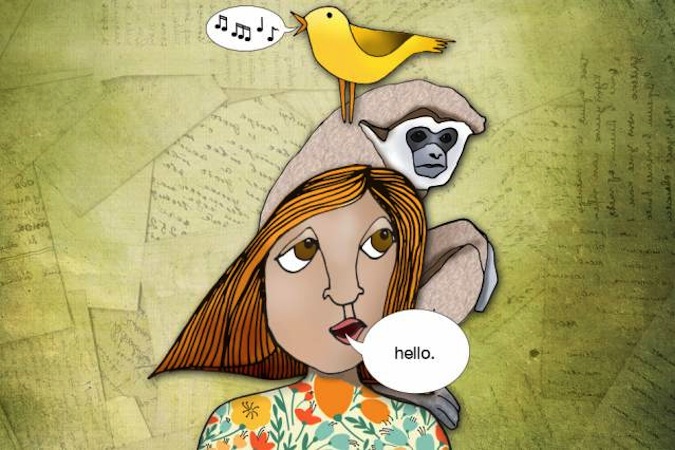Human Language Rooted in Monkey 'Song,' Scientists Suggest

From Shakespearean sonnets to impassioned speeches to lovers' whispers, human language is an amazingly rich form of expression, whose evolution has long puzzled scientists.
Now, some researchers propose that human language represents the blending of two different communication systems, those found in songbirds and monkeys. Content-based language may have its roots in monkey alarm calls, while grammar may come from the expressive parts of bird song.
"One of the big mysteries in the evolution of humans is the evolution of language — it appears to have come out of nowhere 100,000 years ago," said Shigeru Miyagawa, a linguist at MIT in Cambridge, Massachusetts. "There was nothing like it before, and [there is] nothing like it in other animals." [10 Things That Make Humans Special]
Miyagawa and his colleagues said their 'integration hypothesis' could explain how human language, which can theoretically produce infinite meanings, developed from the limited forms of communication seen in the rest of the animal world, the researchers reported June 9 in the journal Frontiers in Psychology.
"Human language didn't just appear out of thin air. There's a perfectly good Darwinian explanation," Miyagawa told Live Science.
Roots of language
Previously, MIT linguist Noam Chomsky proposed that there is just one rule for building structure in language, which he called "Merge," which takes two items and combines them into a set.
Get the world’s most fascinating discoveries delivered straight to your inbox.
The integration hypothesis states that the animal kingdom contains two kinds of communication systems, which the researchers dubbed the expressive and the lexical, and that human language represents the merging of these two.
The expressive system is found in songbirds and corresponds to grammar in human language. Male songbirds sing to attract mates or protect territory, but their songs don't have any concrete meaning in the real world, the researchers said.
The lexical system is found in monkeys and corresponds to words in human language. For example, vervet monkeys use unique alarm calls to warn of specific predators, with calls communicating threats such as "eagle," "snake" or "leopard."
These two systems are widespread in the animal kingdom, but only in humans did they come together as language, the researchers said. Taken alone, these communication systems can produce only finite meanings, but together, they give rise to the potentially infinite meaning of human language.
But how did these two systems merge? "That's the million-dollar question," Miyagawa said.
Humans couldn't have inherited expressive communication from birds, because the last common ancestor of humans and birds lived hundreds of millions of years ago, and evidence suggests language is only about 100,000 years old, Miyagawa said.
But the researchers said another animal appears to use expressive communication: silvery gibbons. These primates produce lengthy, complex songs in order to guard their territory and communicate with potential mates and family members.
The researchers believe this expressive ability is present in other animals, but could be latent. "It's there as part of genetic makeup, but it doesn't get externalized," Miyagawa said.
In order to determine how the expressive and lexical systems may have combined in humans, the researchers plan to look for other mammals that have this expressive ability. [8 Humanlike Behaviors of Primates]
Doubts about hypothesis
But the integration hypothesis received somewhat mixed responses.
"This is an interesting hypothesis that is consistent with much of what we know about animal communication systems, but takes seriously the extremely unusual nature of human language," said Tecumseh Fitch, a cognitive biologist at the University of Vienna, who was not involved with the study. However, Fitch told Live Science, he wished the authors proposed some ways to test the hypothesis.
Miyagawa admitted that finding evidence for events that occurred in the distant past is "challenging," but said it is possible to test his hypothesis by comparing the communication systems of other primates, as well as using modern genomics.
Fitch also disagreed with comparing gibbon song to that of birds, because birdsong is a learned behavior, while gibbons don't learn songs from other gibbons. However, the primates do have neural control over their vocal tract, like songbirds and humans, Miyagawa said.
Other linguists don't buy the integration hypothesis.
"I think it is far too simplistic. It makes the emergence of language seem like a sudden process, like the combination of hydrogen and oxygen to yield water," said Jim Hurford, an emeritus professor of language evolution at the University of Edinburgh, in Scotland.
It's much more likely that a number of social and mental pre-adaptations had been occurring in the ape lineage for a few million years before humans evolved, Hurford told Live Science.
In response, Miyagawa said that "while evolutionary change is often gradual, it can sometimes be very swift, and this has been confirmed by genomic data on several of the traits that make humans different from other species." For example, the ability to digest milk as an adult developed quickly tens of thousands of years ago, he said.
Another criticism comes from William Croft, a linguist at the University of New Mexico, in Albuquerque. "The Chomskyan theory that the authors assume is very controversial, and there are many other theories of language out there, which draw much more on the social and cognitive abilities language employs," Croft told Live Science.
But the researchers said their hypothesis makes sense across a number of competing ideas, including those that are thought to be in direct competition with Chomsky's theory of language.
The integration hypothesis is based largely on linguistics, but fundamentally, language arises from biological processes. Miyagawa said he would like to see how the expressive and lexical language systems might be mapped in the brain.
Follow Tanya Lewis on Twitter and Google+. Follow us @livescience, Facebook & Google+. Original article on Live Science.

